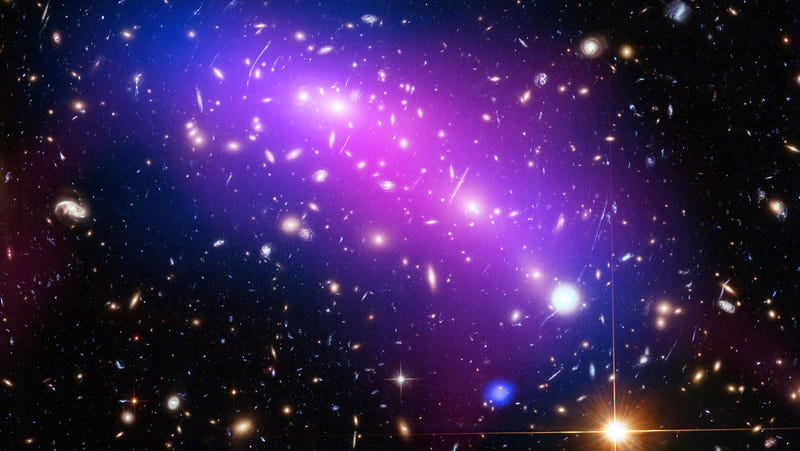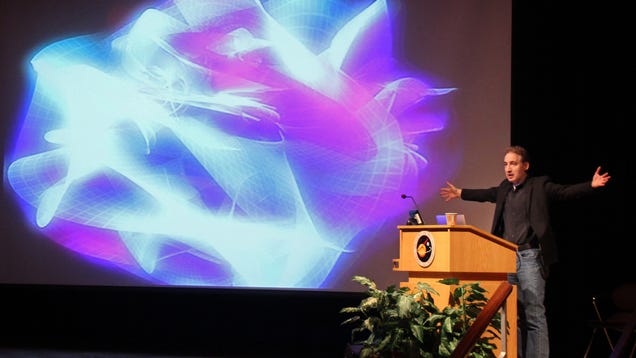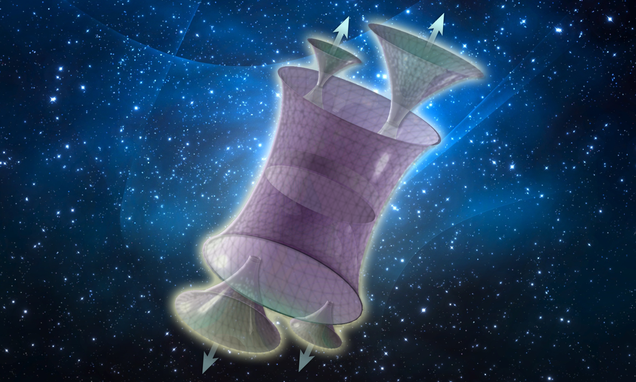
Theoretical physicists and cosmologists deal with the biggest questions, like “Why are we here?” “When did the universe begin?” and “How?” Another questions that bugs them, and likely has bugged you, is “What happened before the Big Bang?” Image Credit: NASA, ESA, CXC, NRAO/AUI/NSF, STScI, and G. Ogrean (Stanford University)
Again, this is a speculation, not theory. “As of yet, these aren't established as laws of physics we understand or have checked in any way,” said Carroll. As Peter Woit, a theoretical physicist at Columbia University put it to Gizmodo, “A general piece of advice around physicists is when they say ‘we don’t understand what’s going on here,’ they really, really mean it. They’re really in the dark.”

Physicist Brian Greene lecturing on string theory (Image: NASA/Goddard/Wade Sisler)
So, now, let’s speculate. One of the strangest properties of our universe is that it has very low entropy, meaning there is relatively low disorder, or conversely a large amount of order, among all of the particles. Think of it this way: Imagine a bomb full of sand exploding onto an empty surface—that’s the Big Bang. You would expect a pretty uniform heap of sand after the explosion, but instead, our universe immediately arranged into lots of sand castles seemingly for no reason and with no help, and we don’t really know why, Stefan Countryman, a physics Ph.D. student at Columbia University, explained to Gizmodo. The Big Bang could have (and maybe should have) resulted in a high-entropy mass of uniformly distributed, disorganized stuff. Instead, we’ve got star systems, galaxies, and galactic clusters all linked together with dark voids between them. We have order.
Additionally, entropy or disorder can only increase over time—without outside help, the sand castles will erode away. In fact, according to Carroll, our observation of time is dependent on increasing entropy since the universe began. Entropy is a physical property that is completely time dependent, riding the one-way time train into the future.
So: the laws of physics say entropy can only increase, and today’s entropy is still very low. Carroll says that means the early universe had to have had even lower entropy—in other words, it must have been even more organized. That has implications for what things were like before the Big Bang. “There’s a lot of a person who think the early universe was simple, smooth and featureless with tiny little ripples and that’s a natural place for universe to start,” said Carroll. “Once you think about entropy... your perspective changes and you realize it’s something you have to explain.”
Entropy aside, there are other important aspects of these theories that have to line up with the universe we now live in. In some cases, winding up a universe with low entropy is less important than others.
As we’ll see, possible explanations for what happened before the Big Bang range from a Big Bounce to an endlessly branching multiverse.
A Bouncing Universe
One idea is that our low entropy universe came out of another, collapsing universe. This notion, sometimes called the Big Bounce, predicts that another universe collapsed inwards, into a point of infinite gravity called a singularity, and then bounced back to produce our own universe. Such models have been aroundsince the 1960s at the latest, with more consideration in the 80s and early 90s. Its possible there have even been multiple bounces; an expand-and-contract cycle full of Big Bangs like a universe accordion.

A supernova, an exploding star (Image: NASA/CXC/SAO)
Big Bounce theories have issues: namely, the idea of a singularity just blowing up violates Einstein’s general relativity, the rules for how gravity works. Physicists believe that singularities probably exist inside black holes. But physical laws don’t give a mechanism by which another universe, once collapsed into a singularity, should bang. A Big Bounce, then, would require adding new particles and fields and coming up with new theories. “There’s nothing in general relativity that says the universe would bounce if it turned into a singularity,” said Carroll.
And there’s an even bigger problem: bouncing universes require forward moving time with decreasing entropy, and as we said before, entropy always increases with time. That means that as far as our established laws of physics are concerned, a bouncing universe can’t happen.
That doesn’t mean a bouncing universe didn’t happen—it could just mean our current theories are incomplete. The laws we’ve established only cover the universe we can observe, after all.
A Hibernating Universe
Maybe before the Big Bang, the universe was a small, slowly evolving fixed space, as theorized by physicists like Kurt Hinterbichler, Austin Joyce and Justin Khoury and others. This pre-Bang universe would have been metastable, meaning it would have been stable only until it basically realized there was a more stable state. As an analogy, imagine a ball sitting in a depression vibrating at the side of the mountain. Any knock could send the ball rolling toward the bottom—or, in the case of our universe, kicking off a Big Bang.
According to some theories, the pre-Bang universe simply could have existed in a flat, high-pressure state for a very long time. Eventually, this metastable period came to an end, causing the universe to inflate (as we’ll explain in a bit) and turn into what we see today.
The hibernating universe theory has its own issue, explained Carroll: It also suggests our universe had a low-entropy beginning, without offering any explanation as to why. Hinterbichler, theoretical physicist at Case Western Reserve University, doesn’t think the low entropy beginning is a problem, however. “We’re just looking for an explanation of the dynamics that happened before the Big Bang that tells some story about why we see what we see,” he said. “That’s the best you can hope for.”
But Carroll thinks that another pre-Bang theory could produce a low-entropy universe like our own.
A Multiverse
Multiverse theory avoids the problems of decreasing entropy over time associated with the Big Bounce, and explains the low entropy universe we observe today, said Carroll. This theory stems from a fairly well-accepted but incomplete idea called “inflation.” Physicist Alan Guth, currently at MIT, coined the term inflation in 1980, which says that space in the universe expanded at incredible speeds right after the Big Bang, far faster than the speed of light. Quantum mechanics says that the space constantly experiences random, tiny fluctuations in energy, and during the inflationary period, those energy peaks and troughs could have magnified and turned into galaxies and voids, the large-scale, low-entropy structure we see in the universe today.
Scientists developed the inflationary model by observing the cosmic microwave background—the oldest, furthest light we can observe from a few hundred thousand years after the start of the Big Bang—and found that inflation perfectly predicted its existence.

Baby universes popping out of a parent universe. Image: Jason Torchinsky
Some scientists think a multiverse is also a consequence of inflation. Essentially, there’s one grand inflationary soup that smaller, low entropy universes sprout out of like bubbles. These universes are unable to ever communicate with one another. As PBS Nova writer Marcus Woo explains:
In the early 1980s, physicists discovered that inflation goes on forever, stopping only in some regions of space. But in between these pockets, inflation continues, expanding faster than the speed of light. These bubbles are thus closed off from each other, effectively becoming isolated universes.
Carroll prefers this particular model, although his multiverse looks a little different from what I’ve described above. “It’s a version of the multiverse theory, but the difference here is that the parent universe can be high entropy,” with low entropy universes sprouting off. This model implies that that before the Big Bang, was the big, inflating space, from which our and other universes emerge. The other universes would be beyond the limits of our detection, and could have began before and after our own.
Woit worries that a multiverse theory, while sexy from a popular science standpoint, will cause physicists to stop looking for the answers to the most basic questions—like why the physical constants in our universe are what they are.
“Theorists had this idea that maybe there are an infinite number of universes, and we can come up with the models where the numbers” like the fundamental properties of the particles we observe, “are different in every baby universe,” said Woit. He wants theorists to avoid saying that we just got lucky that we ended up in this random universe where everything happens to look the way that it does, since there’s infinity possibilities, so let’s give up theorizing. Carroll himself prefers the multiverse, but plenty others prefer the bouncing universe.
So to sum up, lots of physicists get paid to argue and write books about which Big Bang and pre-universe model might describe what we see today. We have simplified the mathematics (and explanations) a lot, but the fact of the matter is, there is a whole lot of theorizing to go before we understand how our universe came to be.
“It’s important to simultaneously let people know that we don’t know what we’re talking about,” said Carroll. “These are speculative ideas that are just beginning to be taken seriously, but there is hope! I think we can actually figure it out if we keep it up.”
